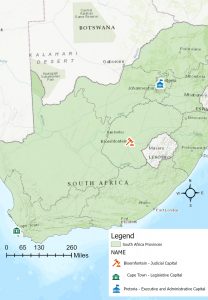34 Sub-Saharan Africa:
Urban Geography I –
South Africa’s Capital Cities
 It seems logical – one country, one capital city. Sometimes, choosing that capital city can be divisive. In Australia, there was a rivalry between Melbourne and Sydney, each suggesting rights to be the national capital. Sometimes capital cities change location, such as in Myanmar where the designated capital changed from Yangon (Rangoon) to Nay Pyi Taw. In a few cases, capital cities are built from scratch, specifically to take on that governmental role (Washington, DC).
It seems logical – one country, one capital city. Sometimes, choosing that capital city can be divisive. In Australia, there was a rivalry between Melbourne and Sydney, each suggesting rights to be the national capital. Sometimes capital cities change location, such as in Myanmar where the designated capital changed from Yangon (Rangoon) to Nay Pyi Taw. In a few cases, capital cities are built from scratch, specifically to take on that governmental role (Washington, DC).
However, it is quite unusual for a country to have more than one capital city. Historically, there have been a few cases. For instance, from 1776 to 1818, Afghanistan had a summer capital in Kabul, but a winter capital in Peshawar. At present, both Bolivia and Eswatini feature two capital cities that split governmental responsibilities. Nevertheless, the Republic of South Africa wins this odd contest by having three national capitals – Pretoria, Cape Town, and Bloemfontein.
Pretoria is the executive and administrative capital of South Africa. Bureaucratic, it is necessary, while as the executive center, it is a focal point for foreign interaction. As one of the oldest and most established cities there, Pretoria was an obvious choice for a capital city. Even now, it retains much of the political iconography of the country. In size, it only ranks fifth at 1.6 million.

Cape Town is the legislative capital. Its coastal location enabled Cape Town to be the first colonial settlement there, over three hundred years ago. The city has always been a national focal point if not capital. Cape Town is the country’s most populated city at 3.4 million. It is a spectacular city that draws the second most tourists to South Africa.
Bloemfontein is the judicial capital, seating the country’s Supreme Court of Appeal. To become this capital, Bloemfontein received some financial compensation in terms of annual payments towards its municipal debt. The city also serves as the capital of the Free State province, but holds only 463 thousand people, ranking 12th in South Africa. Arguably, this city is a strange choice as one of the capital cities.
Oddly, the Constitutional Court of South Africa, a supreme constitutional court, is located in Johannesburg, yet that city is not counted among the capitals of South Africa, probably due to difficult aspects of the Anglo-Boer War of 1895-1902 that precipitated the national consolidation into the Union of South Africa. Johannesburg was not chosen as a national capital of any category. Even as a very productive city, it was viewed as tainted by an imperialist bias. It had been part of the older South African Republic and in the 1910-1994 Transvaal Province. As the capital of both of those territories was not Johannesburg, but Pretoria, the former did not supplant the latter in the broader national picture. However, Johannesburg was the site chosen for the newer Constitutional Court of South Africa, apparently so that this new court (1994) was not viewed as an arm of the Supreme Court of Appeal. And, in 1994 the Gauteng Province was established, holding Johannesburg as its provincial capital, instead of Pretoria. The city ranks #3 in population at two million residents, as well as #1 in tourist visits.

In recent years, South Africa has considered consolidating all three governmental functions into Pretoria; however, opponents have argued against the move, citing the initial costs of building new infrastructure and lamenting the expected corruption that might accompany the process of moving and the reality of a new format. Initial costs have been estimated at R7 billion, in order to produce R500-750 million of annual savings.
The three capitals are the result of the national unification convention of 1909. Due to the tribal and colonial competing interests, the region long had featured centers that had governmental roles as regional capitals or points of national autonomy. The 1909 convention took on the challenge of creating order and regional cooperation.
South Africa remains an oddity with three national capital cities, a situation that is unique in the world. Also odd is the choice to exclude Johannesburg from being even one of those capitals, although its hosting of the Constitutional Court may count as some consolation.
Did you know?
The name of the country is the Republic of South Africa (RSA). On the one hand, that is a bit of a long title, so often the country is referenced as South Africa. On the other hand, for a too casual student, the general direction of southern Africa or south Africa might be confused with the country of South Africa. Thus, be careful with the terminology.
The municipal government of Pretoria has changed the local name to Tshwane.
Both Pretoria and Johannesburg are in the Gauteng Province, which is the smallest in area and largest in population in South Africa.
Bloemfontein was the birthplace of author J. R. R. Tolkien.
Cited and additional bibliography:
Beene, La Tonya. South Africa Capital Cities. College of DuPage GIS Class, May 2022.
Bekker, Simon, and Goran Therborn, eds. Capital Cities in Africa: Power and Powerlessness. HSRC Press, 2012.
Council on Foreign Relations. “South Africa’s Three Capitals.” Accessed October 8, 2021. https://www.cfr.org/blog/south-africas-three-capitals.
“How Much It Will Cost to Make Pretoria the Only Capital City in South Africa.” Accessed October 8, 2021. https://businesstech.co.za/news/government/112601/how-much-it-will-cost-to-make-pretoria-the-only-capital-city-in-south-africa/.

